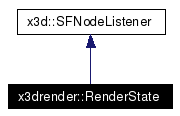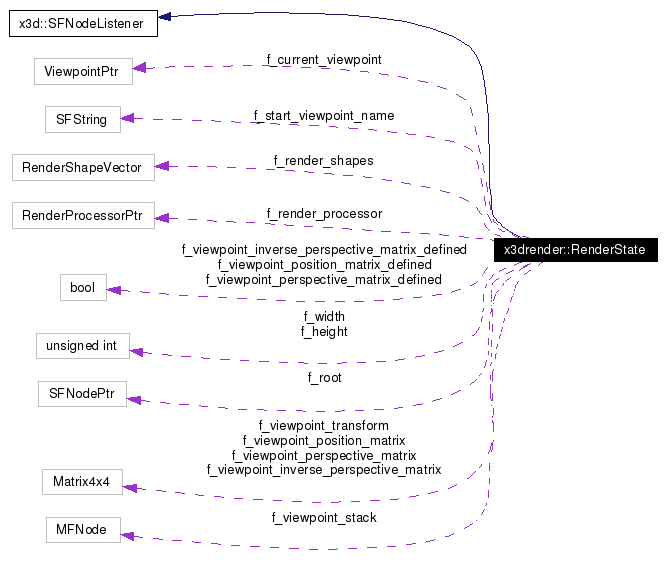
|
X3D libraries
The libraries to work with X3D dataset
|

|
x3drender::RenderState Class Reference
Create a render state and then render it. More...
#include <render.h>
Inheritance diagram for x3drender::RenderState:


Public Member Functions | |
| void | ApplyTransform (const x3d::SFNode *node, fast_math::Matrix4x4 &matrix) |
| Apply the transformation defined in a node to a matrix. | |
| bool | Execute (RenderShape::execute_function_t func) |
| Execute a function on all the render shapes of this state. | |
| const x3d::SFString & | GetViewpointDescription () const |
| Get the current viewpoint description if any. | |
| const fast_math::Matrix4x4 & | GetViewpointInversePerspectiveMatrix () |
| Get the current viewpoint inverse perspective matrix. | |
| const fast_math::Matrix4x4 & | GetViewpointPerspectiveMatrix () |
| Get the current viewpoint perspective matrix. | |
| const fast_math::Matrix4x4 & | GetViewpointPositionMatrix () |
| Get the current viewpoint position matrix. | |
| bool | Initialize (x3d::SFNodePtr root) |
| Initialize the render state with a tree of nodes. | |
| RenderState (RenderProcessor *render_processor) | |
| Initialize a render state. | |
| void | SetScreenSizes (unsigned int width, unsigned int height) |
| Defines the width and height of the output screen. | |
| void | SetViewpointName (const char *name) |
| Set the name of the viewpoint to start with. | |
| bool | Update () |
| Update all the render shape which needs to be updated. | |
| virtual | ~RenderState () |
| Get rid of all the resources used by the RenderState object. | |
Private Member Functions | |
| void | SetCurrentViewpoint (x3d::Viewpoint *viewpoint) |
| Change the current viewpoint properly. | |
| bool | SetupShape (x3d::SFNodePtr node, x3d::MFNode parents, fast_math::Matrix4x4 &matrix) |
| Finalize the RenderShape setup. | |
| bool | WalkTree (x3d::SFNodePtr node, x3d::MFNode parents, fast_math::Matrix4x4 &matrix) |
| This function walks a tree of node to find shapes. | |
Private Attributes | |
| x3d::ViewpointPtr | f_current_viewpoint |
| unsigned int | f_height |
| RenderProcessorPtr | f_render_processor |
| RenderShapeVector | f_render_shapes |
| x3d::SFNodePtr | f_root |
| x3d::SFString | f_start_viewpoint_name |
| fast_math::Matrix4x4 | f_viewpoint_inverse_perspective_matrix |
| bool | f_viewpoint_inverse_perspective_matrix_defined |
| fast_math::Matrix4x4 | f_viewpoint_perspective_matrix |
| bool | f_viewpoint_perspective_matrix_defined |
| fast_math::Matrix4x4 | f_viewpoint_position_matrix |
| bool | f_viewpoint_position_matrix_defined |
| x3d::MFNode | f_viewpoint_stack |
| fast_math::Matrix4x4 | f_viewpoint_transform |
| unsigned int | f_width |
Detailed Description
Create a render state and then render it.
Constructor & Destructor Documentation
|
|
Initialize a render state.
The render processor will know how to create the render shapes (it may have some extra fields in its render shapes than in the system render shapes.) The processor is also capable of rendering the shapes on screen or in a buffer.
|
|
|
Get rid of all the resources used by the RenderState object. Note that the need for this function is mostly in case we get some virtual functions.
|
Member Function Documentation
|
||||||||||||
|
Apply the transformation defined in a node to a matrix. This function will determine the type of a node and if it is some sort of transformation node (not just a Transform node) then the transformation will be applied to the input matrix. This is used whenever the tree of nodes is traversed to setup all the RenderShape and later whenever an individual shape's transformation changes.
|
|
|
Execute a function on all the render shapes of this state.
The function being called may return false in which case the loop breaks and the Execute() function returns false. This can be used to search for a specific node, for instance. By default, your functions should always return true (success).
|
|
|
Get the current viewpoint description if any. This function returns the current viewpoint description. The content of the string will change with each viewpoint.
|
|
|
Get the current viewpoint inverse perspective matrix. The viewpoint defines a perspective matrix with a direction, an orientation and a field of view. The field of view is used to create the projection matrix for OpenGL. Also, the inverse can be used to compute the screen pixel position of your objects. This function returns that matrix. Note that the direction and orientation are computed in the viewpoint position matrix and you will also need it to compute the screen position of your objects.
|
|
|
Get the current viewpoint perspective matrix. This function can be used to request the viewpoint perspective matrix. It will be computed only once, unless the viewpoint changes and forces the function to recompute a new frustum. We compute the viewpoint perspective matrix ourselves (instead of using the gluPerspective() function which would do it for us) because we need it in order to sort the shapes in Z order from back to front. That is, we need the inverse matrix, but it is easier to compute the projection first and then compute its inverse. Note since we already have this matrix available in all cases, you can get it to setup the projection matrix in OpenGL. The matrix is defined as follow: | f/aspect 0 0 0 | | 0 f 0 0 | | 0 0 p q | | 0 0 -1 0 | with p = (zfar + znear) / (znear - zfar) q = 2 * zfar * znear / (znear - zfar) and f = 1 / tan(fovy / 2) The fovy is the vertical field of view (when the Y coordinates go from the bottom of the screen to the top). far and near are computed internally. The aspect ratio is defined as: screen width / screen height For the aspect ratio to be computed properly, you need to setup the screen width and height with SetScreenSizes().
|
|
|
Get the current viewpoint position matrix. This function can be used to request the viewpoint position matrix. It will be computed only once, unless the viewpoint changes and forces the function to recompute a new position. We compute the viewpoint position matrix ourselves (instead of using the glRotatef() and glTranslatef() functions which would do it for us) because we need it in order to sort the shapes in Z order from back to front. This matrix will be multiplied by each object matrix to know exactly where such and such object is in the current world. Note since we already have this matrix available in all cases, you can get it to setup the model view matrix in OpenGL. The matrix is defined as the product of:
|
|
|
Initialize the render state with a tree of nodes.
The root node can be of nearly any type (i.e. X3D, Scene, or even directly a Shape.) You cannot specify a node which is a child of a Shape (Appearance, Geometry node, etc.).
|
|
|
Change the current viewpoint properly. The render state needs to listen to the viewpoint since whenever it changes, all the shapes Z order may change and therefore we will need to recompute all the shape positions properly. This function takes care of removing the previous listener from the previous viewpoint and setup the new viewpoint with this listener. The render state itself is the listener.
|
|
||||||||||||
|
Defines the width and height of the output screen.
It is expected to be set to the width and height of the output window. It is used to compute the perspective of the projection matrix.
|
|
||||||||||||||||
|
Finalize the RenderShape setup.
For internal use only. This function finalizes the render shape setup by setting up the parent nodes and the matrix and then walk the tree under the shape object to get the geometry and the appearance of the shape. |
|
|
Set the name of the viewpoint to start with.
|
|
|
Update all the render shape which needs to be updated. This function will update all the shapes found in the list of shapes to be rendered in this render state.
|
|
||||||||||||||||
|
This function walks a tree of node to find shapes.
For internal use only.
|
Member Data Documentation
|
|
|
|
|
|
|
|
|
|
|
|
|
|
|
|
|
|
|
|
|
|
|
|
|
|
|
|
|
|
|
|
|
|
|
|
|
|
|
|
|
|
|
|
|
The documentation for this class was generated from the following files:
